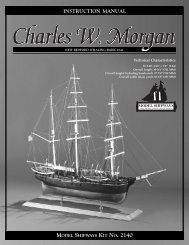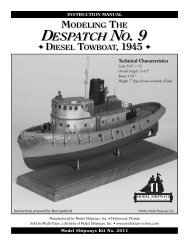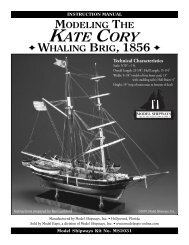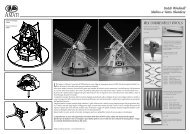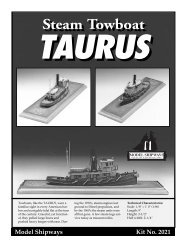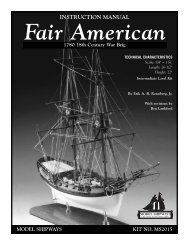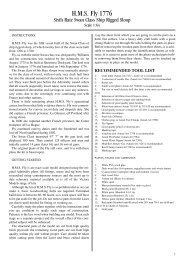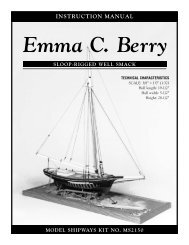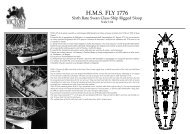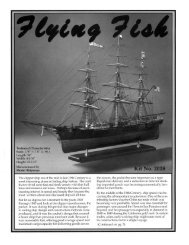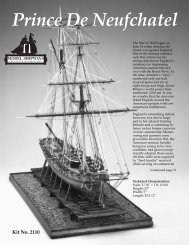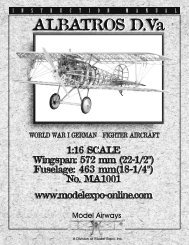download benjamin latham instruction manual
download benjamin latham instruction manual
download benjamin latham instruction manual
You also want an ePaper? Increase the reach of your titles
YUMPU automatically turns print PDFs into web optimized ePapers that Google loves.
Silver Solder: If extra strength is desired, and also to<br />
avoid the lead in softer solder, silver solder can be used.<br />
A propane torch is a must, as the melting point of silver<br />
solder is much higher. Clean the metal and apply the flux<br />
(liquid silver solder flux is better than the borax type). Cut<br />
a very small piece of solder and lay it next to the joint.<br />
This is necessary because, unlike soft solder, silver solder<br />
will not break away from the roll. It tends to ball up on<br />
the end. Next, heat the joint and solder it together. When<br />
the correct temperature is reached the solder will jump<br />
into the joint––job completed! Be careful to remove the<br />
heat as soon as possible, because the brass also will be<br />
near its melting point.<br />
Figure 1a illustrates how to make mast bands, eyebolts<br />
and rings. Rings can be soldered after they are used on<br />
the model, or not soldered at all, unless there is some<br />
strain on the ring from rigging.<br />
FIG. 1a - Making Mast Bands, Eyebolts and Rings<br />
MAST BANDS<br />
Flux/solder<br />
all joints<br />
Real ship<br />
EYEBOLTS<br />
After soldering,<br />
drill, cut and file<br />
to shape<br />
Pins to hold<br />
parts in place<br />
Form around drill or rod<br />
Solder<br />
Cut off as required<br />
Wood jaws in vise<br />
Form around<br />
dowel or drill<br />
Cut from<br />
sheet brass<br />
WHAT YOU’LL NEED TO START CONSTRUCTION<br />
The following tools and supplies are recommended for the<br />
construction process. Modelers who have built before may have<br />
their own favorites.<br />
A. Knives & Saws<br />
1. Hobby knife with No. 11 blades<br />
2. Coping saw (or jeweler’s saw frame) and fine blades<br />
3. Razor saw<br />
B. Files – Set of needle files<br />
C. Carving Tools – Small chisel for carving center keel rabbet<br />
D. Sharpening Stone – Necessary to keep the tools razor sharp<br />
E. Clamps<br />
1. A few small C-clamps<br />
2. Several wooden clothespins<br />
3. Rubber bands<br />
F. Wire Cutters & Tin Snips<br />
For cutting fine wire & chain; for cutting brass sheet<br />
G. Boring Tools<br />
1. Set of miniature drills: #60 to #80<br />
2. A pin vise<br />
3. Larger bits: 1/16”, 3/32”, and 1/8”<br />
H. Miscellaneous<br />
1. Tack hammer<br />
2. Tweezers (a few)<br />
3. Small fine pointed scissors<br />
4. Miniature pliers<br />
a. small round for forming rings and eyes<br />
b. flat nose (with serrated jaws)<br />
5. Draftsman’s dividers<br />
6. Proportional dividers<br />
7. Bench vise (small) with own base for moving around<br />
8. Soldering iron with 1/8” diameter tip and/or propane torch<br />
a. solder<br />
b. flux<br />
9. Sewing thread (for seizings & lanyards; other rigging in kit)<br />
a. black<br />
10.<br />
11.<br />
b. beige<br />
Beeswax (for treating rigging lines)<br />
1/2” or 3/4” masking tape<br />
I. Sandpaper – Fine and medium grit garnet or aluminum oxide<br />
sandpaper (#100 to #220 grit)<br />
J. Finishing: – Paint brushes<br />
1. Fine point for details<br />
2. 1/4” to 1/2” flat square for hull<br />
K. Supplies: – (will be covered in detail in the Painting &<br />
Staining section and throughout <strong>instruction</strong>s.)<br />
1. Paints<br />
2. Primer<br />
3. Stains/varnish<br />
4. White or Carpenter’s (yellow) wood glue<br />
5. Five-minute epoxy<br />
6. Super glue<br />
L. Cotton or linen cloth: (fine weave) for sails, if added<br />
M. Plastic: Plastic sheet or glass for windows, skylights<br />
Wrap wire<br />
around rod<br />
Saw or cut with<br />
hobby knife<br />
RINGS<br />
Bend in<br />
line – solder<br />
Note about Glues: White or Carpenter’s yellow wood glue will<br />
suffice for most of the model. Five-minute epoxy provides extra<br />
strength for gluing fittings. Cyanoacrylate (Super) glue such as Jet,<br />
can be used for quick adhesion and is ideal for dabbing onto a<br />
rigging seizing to hold it in place. The best cyanoacrylate glue for<br />
most applications is a medium viscosity gap-filling type. The<br />
watery-thin type is recommended to fill a narrow crack by<br />
capillary action and for quick setting of hull planking.<br />
7



